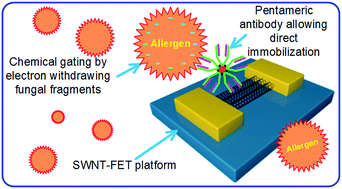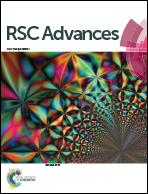Real-time selective monitoring of allergenic Aspergillus molds using pentameric antibody-immobilized single-walled carbon nanotube-field effect transistors†
Abstract
Airborne fungus, including Aspergillus species, is one of the major causes of human asthma. Conventional immunoassay or DNA-sequencing techniques, although widely used, are usually labor-intensive, time-consuming and expensive. In this paper, we demonstrate a sensor for the rapid detection of Aspergillus niger, a well-known allergenic fungal species, using single-walled carbon nanotube (SWNT) field effect transistors (FETs) functionalized with pentameric antibodies that specifically bind to Aspergillus species. This strategy resulted in the real time and highly sensitive and selective detection of Aspergillus due to an electrostatic gating effect from the Aspergillus fungus. This mechanism is in contrast to a previously reported Aspergillus sensor, which was based on mobility modulation from Aspergillus adsorption. Also, our sensor shows a much wider detection range from 0.5 pg mL−1 to 10 μg mL−1 with a lower detection limit of 0.3 pg mL−1. The resulting SWNT-FET was able to selectively detect Aspergillus molds in the presence of more concentrated amounts of other mold species such as Alternaria alternata, Cladosporium cladosporioides, and Penicillium chrysogenum. We expect that our results can be used in real-time monitoring of the indoor air quality of a variety of public facilities for the elderly and children, who are more vulnerable to environmental biohazards.


 Please wait while we load your content...
Please wait while we load your content...